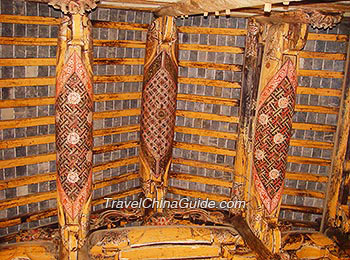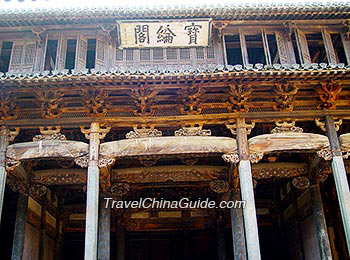
Foreign travelers visiting Chengkan Village will be eligible for a preferential 50% discount on the entrance fee in the whole year of 2024.
Chengkan Village, about 40km (25 miles) to the north of Huangshan City in Anhui Province, is a well-preserved ancient village with appealing scenery of mountains and waters and age-old residences with rich local characteristics. Hailed as the "Town of China's Old Buildings", Chengkan Village has over 150 ancient residences, among which 21 are major cultural relics under state protection. With stunning landscapes but fewer visitors compared to
Xidi and
Hongcun ancient villages, Chengkan Village is a worthwhile destination during your journey to Anhui Province.
Chengkan Village has a lot to do with the Taiji philosophy in Chinese culture. Eight mountains surrounding Chengkan Village, combined with the S-shaped Zhongchuan River winding its way through the village, forms a pattern of Bagua, meaning
Eight Diagrams. Thus, the village is also widely known as Bagua Village. According to the Taiji philosophy, Yang is Cheng while Yin is Kan, so the village is called Chengkan.
The winding, twisting streets and lanes interlace in the village, ancient residences are arranged in orderly rows, making the village a maze where first-time visitors could easily get lost. Three main streets and 99 lanes are all paved with granite slabs. Strolling in such a village must be a joy.
Recommended Route
To learn about the story of these ancient buildings and avoid losing your way, you are suggested to hire a local guide. But if you feel like taking an independent tour, here is a recommended route for your reference.
Shuikou (Water Gap) - Baolun Hall - Zhongying Street - Huanxiu Bridge - Luo Chunfu's Residence - Yanyi Hall - the Lower House - Changchun Temple
Shuikou is the entrance to the village, where there is a square and a pond full of lotuses in summer.
Baolun Hall
The first attraction you will encounter is Baolun Hall, a must-see spot in Chengkan Village. It is part of Luo Dongshu's Ancestral Temple, built by Luo's descendants to worship him. Luo Dongshu was a noted scholar as well as a hermit at the end of the Song Daynasty who made a great contribution to the Luo Family in Chengkan.
 | | Creative Paintings on Crossbeams | |  | | Baolun Hall | |
Visitors need to pass three entrances to reach the hall. Stepping into the first entrance Yi Gate, visitors will be attracted by the great patio. The great hall behind the second entrance features six towering stone pillars and 24 thick wooden pillars. Finally the magnificent Baolun Hall appears in front of you after the third entrance. It is the highlight of the whole temple.
The hall was first built around 1542 during the
Ming Dynasty (1368 - 1644). How colors of the drawings and patterns are still vivid after 500 years remains a mystery. Moreover, you can feel the unique ancient Anhui culture from the beautifully designed sculptures of lions, clouds, and lotuses on bluestone parapets, wooden eaves and crossbeams. Two wooden staircases of more than 30 steps each lead you up to an attic, the highest spot of the village, where you can see the beautiful Huangshan Mountain in the distance.
Zhongying Street
Zhongying Street is one of the three main streets in Chengkan Village. Its name Zhongying means a place endowed with talents, given by a famed calligrapher in the Ming Dynasty. In Zhongying Street, what you can discover is Zhongying Residence which is now open for sightseeing or having a rest.
Huanxiu Bridge
Turn right and walk for few minutes and you will reach Huanxiu Bridge, the oldest structure in the village, which was built in the
Yuan Dynasty (1271 - 1368). As a water village, bridges can be found every now and then, among which Huanxiu Bridge is the most famous one. At the end of the bridge is a house storing numerous wood carvings, porcelain, and embroideries.
Luo Chunfu's Residence
Built in 1730, Luo Chunfu's Residence differs itself from other buildings at that time. The gate is made of granite slabs and black bricks, decorated with elegant reliefs and overhanging eaves. All beams and pillars in the main house are adorned with exquisite wood carvings.
Yanyi Hall
Yanyi Hall is said to be the residence of a famous doctor in the Ming Dynasty. It is a three-storey house presenting primitive simplicity. The first storey is where the master lived while the second was for the son. The third storey functioned as the study and counting room.
Lower House
To the south of Yanyi Hall is the Lower House, where there is a hall displaying information about
I Ching, also known as the Book of Changes.
Changchun Temple
Changchun Temple was where the Luo Family and neighboring villagers worshipped the God of the Earth. In spring, they prayed for favorable weather for crops while in autumn they thanked the god for a bumper harvest.
How to get to Chengkan Village
From Huangshang City
1. Take tourist bus no. 3 at Huangshan Coach Station, also called Tunxi Coach Station, and get off at Chengkan Ancient Village. It takes about 40 minutes to Chengkan. The bus departs at 8:00, 9:00, 10:00, 11:00, 13:00, 14:00, 15:00, and 16:00 every day. The returning bus follows the same schedule. It also passes
Qiankou Residence. You can visit the two attractions in one day.
2. If you arrive at
Huangshan North Railway Station, you can take a bus from there to the village. The bus departs at 14:05. The bus fare is CNY 10 and the duration is 30 minutes.
There are private buses to the village from Tangkou, which is only 0.8 mile (1.3km) from the south gate of the Huangshan Mountain.
| Entrance Fee | CNY 107
Children between 1.2 and 1.5m (3.9 and 4.9 feet) can enjoy half price while those under 1.2m can enter for free. |
| Opening Hours | 7:30 - 18:00 |
| Recommended Time for a Visit | Half a day |

Recommended Guided Tours to Chengkan Village:
 5 Days Huangshan Photography Tour from $799
5 Days Huangshan Photography Tour from $799 Top 9 Things to Do in Huangshan
Top 9 Things to Do in Huangshan
- Last updated on Jan. 05, 2024 by Gabby Li -

